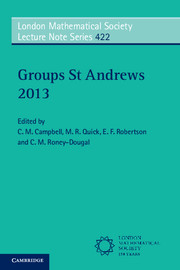Book contents
- Frontmatter
- Contents
- INTRODUCTION
- Approximate subgroups and super-strong approximation
- Width questions for finite simple groups
- Profinite properties of discrete groups
- GL(n, Z), Out(Fn) and everything in between: automorphism groups of RAAGs
- Permutation groups and transformation semigroups: results and problems
- New progress on factorized groups and subgroup permutability
- A survey on the normalizer problem for integral group rings
- A survey on Clifford-Fischer theory
- A generalisation on the solvability of finite groups with three class sizes for normal subgroups
- Automorphism groups of non-orientable Riemann surfaces
- What are the C2-groups?
- Resurrecting Wells’ exact sequence and Buckley's group action
- Recent work on Beauville surfaces, structures and groups
- Something for nothing: some consequences of the solution of the Tarski problems
- The groups of projectivities in finite planes
- On the relation gap and relation lifting problem
- Some results on products of finite subsets in groups
- Formal languages and group theory
- On the Castelnuovo-Mumford regularity of the cohomology of fusion systems and of the Hochschild cohomology of block algebras
- Recent advances on torsion subgroups of integral group rings
- On finite groups with small prime spectrum
- Solvability criteria for finite loops and groups
- The rational subset membership problem for groups: a survey
- A survey of Milnor laws
- Capable p-groups
- On the normal structure of a finite group with restrictions on the maximal subgroups
- Certain monomial characters and their normal constituents
- Recognition of finite quasi-simple groups by the degrees of their irreducible representations
- Generalized Baumslag-Solitar groups: a survey of recent progress
- Zeta functions of groups and rings – recent developments
Automorphism groups of non-orientable Riemann surfaces
Published online by Cambridge University Press: 05 September 2015
- Frontmatter
- Contents
- INTRODUCTION
- Approximate subgroups and super-strong approximation
- Width questions for finite simple groups
- Profinite properties of discrete groups
- GL(n, Z), Out(Fn) and everything in between: automorphism groups of RAAGs
- Permutation groups and transformation semigroups: results and problems
- New progress on factorized groups and subgroup permutability
- A survey on the normalizer problem for integral group rings
- A survey on Clifford-Fischer theory
- A generalisation on the solvability of finite groups with three class sizes for normal subgroups
- Automorphism groups of non-orientable Riemann surfaces
- What are the C2-groups?
- Resurrecting Wells’ exact sequence and Buckley's group action
- Recent work on Beauville surfaces, structures and groups
- Something for nothing: some consequences of the solution of the Tarski problems
- The groups of projectivities in finite planes
- On the relation gap and relation lifting problem
- Some results on products of finite subsets in groups
- Formal languages and group theory
- On the Castelnuovo-Mumford regularity of the cohomology of fusion systems and of the Hochschild cohomology of block algebras
- Recent advances on torsion subgroups of integral group rings
- On finite groups with small prime spectrum
- Solvability criteria for finite loops and groups
- The rational subset membership problem for groups: a survey
- A survey of Milnor laws
- Capable p-groups
- On the normal structure of a finite group with restrictions on the maximal subgroups
- Certain monomial characters and their normal constituents
- Recognition of finite quasi-simple groups by the degrees of their irreducible representations
- Generalized Baumslag-Solitar groups: a survey of recent progress
- Zeta functions of groups and rings – recent developments
Summary
Abstract
This paper is a survey on automorphism groups of compact unbordered non-orientable surfaces with dianalytic structures, called non-orientable Riemann surfaces. We deal with different aspects of groups acting on these surfaces, as the maximum order and minimum genus problems, the determination of the symmetric crosscap number of a finite group and the fixed point set of an automorphism. The guiding theme linking the sections of this survey comes from the Riemann uniformization theorem, which relates these surfaces to the combinatorial group theory of non-Euclidean crystallographic groups. Some other areas are also related to these surfaces, amongst which we mention real algebraic curves.
Introduction
It is easy to see that a classical analytic structure existing on orientable topological surfaces cannot exist on non-orientable ones. One can, however, relax a bit the notion of analyticity of a structure allowing the complex conjugation to be involved for transition functions between charts with overlapping domains. Such structures, called dianalytic, can exist on non-orientable closed surfaces. Sometimes they are also called conformal – motivated by the fact that the transition functions are angle-preserving but not necessarily orientation-preserving – while usually for classical structures of Riemann surfaces the term analytic is reserved. This way we obtain the notion of unbordered non-orientable Klein surface. These surfaces were called non-orientable Riemann surfaces by Singerman in [35], and we will keep here this convention. Similarly, a self-homeomorphism of such a surface is said to be an automorphism if its local forms are either analytic or the composite of complex conjugation with an analytic function.
The topic we present here is at the intersection of several important disciplines of mathematics: theory of functions of one complex variable (classical Riemann surfaces), algebraic geometry (algebraic curves), low-dimensional topology (mapping class groups, three-dimensional hyperbolic manifolds), Galois theory (automorphisms of algebraic function fields in one variable), differential geometry (moduli spaces, complex surfaces), combinatorics (regular maps on surfaces) and combinatorial group theory. This last is the main tool used to prove the results we present here, and that makes this survey suitable to this volume.
- Type
- Chapter
- Information
- Groups St Andrews 2013 , pp. 183 - 193Publisher: Cambridge University PressPrint publication year: 2015
- 2
- Cited by



